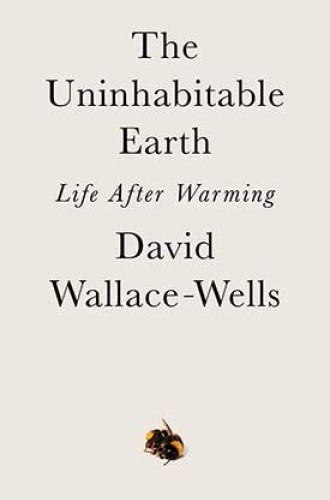Can we survive the incalculable damage of climate change?
David Wallace-Wells charts a path for life in the wake of global warming.
The Amazon forests, which scrub one-fourth of the carbon from the earth’s atmosphere, are burning. Nearly 90,000 fires consume 2,200 square kilometers each month. The most powerful North Atlantic hurricane yet, Dorian, recently drowned island airports in six feet of water before veering toward the Atlantic coast of the United States. Global air and ocean temperatures in July 2019 exceeded 20th-century averages by 1.77 degrees Fahrenheit—the hottest July since records began in 1880 and the 415th consecutive above-average month.
Is it still possible to assess climate threats and risks in a thoughtful and comprehensive way, without polemics or panic? A month ago my answer was no. But then I read this book.
Don’t be misled by its apocalyptic title. The Uninhabitable Earth, an exceptionally clear and concise account of how humanity has changed the living and the nonliving world, looks toward what lies ahead. David Wallace-Wells draws on an enormous range of sources—discursive endnotes take up nearly a quarter of the book’s pages—in describing the complex causes, the uncertainties of prediction, and the possibility that, if we overcome denial and complacency, we may still be able to slow the devastation we have set in motion.
To slow, not to stop. The world around us has changed irrevocably, and we cannot go back. Wallace-Wells, a science writer and editor at New York magazine, recounts cascades of environmental decline: greenhouse gases warm the oceans, melting Arctic ice fields, reducing reflected sunlight, warming water and air, devastating forests, increasing erosion . . . and the chain goes on.
Failing dams in Brazil and mudslides in California are climate-driven cascades in the literal sense. Causal links from atmospheric carbon to tropical storms and advancing deserts are indirect, more difficult to delineate. There is much that we do not know.
But we do know that the environmental disasters of the past decade are only a foretaste of what lies ahead. No one who understands and respects scientific inquiry can challenge that sobering conclusion. Wallace-Wells explains:
We have not, after all, arrived at a new equilibrium. It is more like we’ve taken one step out on the plank off a pirate ship. Perhaps because of the exhausting debate over whether climate change is “real,” too many of us have developed a misleading impression that its effects are binary. But global warming is not a “yes” or “no,” nor is it “today’s weather forever” or “doomsday tomorrow.” It is a function that gets worse over time as we continue to produce greenhouse gas.
We may not be able to pinpoint how or when we first stepped onto the plank, but the precariousness of our position is clear.
In twelve brief chapters, Wallace-Wells reviews the challenges we face, from local calamities like heat death, hunger, drowning, and wildfire to “system crises” like refugee displacement, regional conflict, and increased suicide rates. He stresses that these threats are all interconnected:
For the sake of clarity, I’ve treated each of the threats from climate change—sea-level rise, food scarcity, economic stagnation—as discrete threats, which they are not. Some may prove offsetting, some mutually reinforcing, and others merely adjacent. But together they form a latticework of climate crises, beneath which at least some humans, and probably many billions, will live. How?
Consciously or unconsciously, Wallace-Wells here echoes Ezekiel (33:10): “Our transgressions and our sins weigh upon us, and we waste away because of them; how then can we live?” Nowhere in the remaining seven chapters, unfortunately, does he note the role of faith communities in either fostering apathy or stirring up activism.
Wallace-Wells answers the question by sketching a “kaleidoscope” of responses to the climate crisis. Meaning comes from stories, he believes, and he offers a variety of narratives.
If our affluence rests on environmental exploitation, for example, a radically reformed global economy may achieve sustainability. Industry can decarbonize, energy can be renewable, and agriculture can become sustainable. The cost will be staggering—perhaps 40 percent of our economic output, and a future of meatless meals—but it is not impossible.
Another narrative looks to novel technologies that could block solar radiation. Others focus on isolation and self-sufficiency (and indeed some people are already living off the grid, while others are investing in future colonies in space). Others envision erasure of all borders in a global state that would eradicate poverty and conflict. Each story is far-fetched and implausible. But all are possible human futures.
Perhaps our greatest intellectual challenge, Wallace-Wells observes, is overcoming our intractable belief in a future world that’s more advanced in technology, more affluent, more peaceful, and more cooperative than our current era. The realities of climate change refute such optimism.
The possibility that our grandchildren could be living forever among the ruins of a much wealthier and more peaceful world seems almost inconceivable from the vantage of the present day, so much do we still live within the propaganda of human progress and generational improvement. But of course it was a relatively common feature of human history before the advent of industrialization.
Such an outcome is not inevitable, but neither is it unthinkable.
Wallace-Wells reviews the arguments of scientists and activists who have given up hope for human survival on a warmer planet with larger oceans, smaller forests, and unceasing storms. Such fatalism, he insists, is unfounded. In the face of environmental catastrophe, Wallace-Wells still sees the potential for concerted and effective advocacy, leading to far-reaching reorganization of politics and society that can sustain a livable world.
Granted, the destruction already caused by a one-degree Celsius rise in global temperature cannot be reversed. We probably cannot avoid a two-degree increase, the worst outcome envisioned in the 2018 report of the Intergovernmental Panel on Climate Change, a report whose core message Wallace-Wells summarizes informally thus: “It is okay, finally, to freak out.” But concerted action by governments and citizens around the world may still block a rise of three or more degrees.
Already we see incalculable damage to coral reefs, Arctic permafrost, crops, and forests. “If this strikes you as tragic, which it should,” Wallace-Wells writes, “consider that we have all the tools we need, today, to stop it all: a carbon tax and the political apparatus to aggressively phase out dirty energy; a new approach to agricultural practices and a shift away from beef and dairy in the global diet; and public investment in green energy and carbon capture.”
To use these tools, we must see the world differently, he explains, quoting the Pulitzer Prize–winning novelist Richard Powers: “We have to un-blind ourselves to human exceptionalism. That’s the real challenge. Unless forest health is our health, we’re never going to get beyond appetite as a motivator in the world.”
The prospects for such change are bleak, with the collapse of political leadership in much of the developed world. But fatalism is not the answer—neither for Wallace-Wells, nor certainly for any who believe the world did not stumble into existence by blind chance. The earth was made for us, we profess, and we for the earth. A book like this can help us hold to our faith and summon the energy to seek the earth’s healing.
A version of this article appears in the print edition under the title “Can the earth be saved?”






